
International Journal of Mechanics and Materials in Design
Scope & Guideline
Empowering Engineers with Knowledge in Mechanics and Materials
Introduction
Aims and Scopes
- Mechanics of Materials:
Research on the mechanical behavior of different materials under various loading conditions, including elasticity, plasticity, and fracture mechanics. - Optimization Techniques:
Development and application of optimization methods, including topology optimization and multi-objective optimization, for enhancing material performance and structural design. - Computational Modeling:
Utilization of numerical methods and computational simulations to analyze complex mechanical systems and materials, including finite element methods (FEM) and peridynamics. - Innovative Materials:
Investigation into new materials and composites, including functionally graded materials, piezoelectric materials, and smart materials, focusing on their unique mechanical properties. - Dynamic and Static Analysis:
Studies on the dynamic and static behavior of structures and materials, including vibration analysis, stability, and response to dynamic loading. - Uncertainty Quantification:
Research addressing the impact of uncertainties in material properties and loading conditions on the reliability and performance of mechanical systems.
Trending and Emerging
- Machine Learning and Data-Driven Approaches:
An increasing number of studies are incorporating machine learning techniques for predictive modeling, optimization, and analysis, highlighting the importance of data-driven methods in mechanical design. - Additive Manufacturing and 3D Printing:
Research related to additive manufacturing processes and the design of novel materials suitable for 3D printing is rapidly growing, reflecting the industry's shift towards more flexible and innovative manufacturing techniques. - Smart and Responsive Materials:
There is a notable increase in research on smart materials that respond to environmental stimuli, such as piezoelectric and shape-memory alloys, indicating a trend towards developing advanced materials with adaptive capabilities. - Dynamic and Impact Analysis:
Studies focusing on the dynamic behavior of materials and structures, particularly under impact loading conditions, are becoming more prevalent, emphasizing the need for resilience in engineering designs. - Sustainability and Eco-Friendly Materials:
Emerging themes around sustainable design practices and the use of eco-friendly materials are gaining importance, reflecting a broader commitment to environmental considerations in engineering.
Declining or Waning
- Traditional Material Studies:
Research focusing solely on traditional materials like metals and ceramics without innovative applications or modifications has seen a decline, as the field shifts towards more advanced materials. - Basic Analytical Models:
The use of simplistic analytical models for mechanical analysis is decreasing as researchers increasingly prefer complex numerical simulations that provide more accurate and detailed insights. - Static Structural Analysis:
The emphasis on purely static analysis without considering dynamic effects has reduced, reflecting a growing recognition of the importance of dynamic loading conditions in real-world applications. - Single-Objective Optimization:
There is a decreasing focus on single-objective optimization studies as multi-objective and adaptive optimization techniques gain prominence in addressing complex design challenges. - Experimental Validation of Theoretical Models:
The frequency of studies solely focused on validating theoretical models through basic experiments has decreased, as there is a stronger push for integrated computational-experimental approaches.
Similar Journals
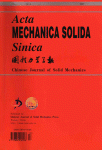
ACTA MECHANICA SOLIDA SINICA
Connecting Researchers in the Realm of Solid MechanicsACTA MECHANICA SOLIDA SINICA is a prestigious journal published by Springer, dedicated to advancing research in the fields of Computational Mechanics, Mechanical Engineering, and Mechanics of Materials. Since its inception in 1981, the journal has established a significant presence in the academic community, holding a commendable Q2 ranking across its categories as of 2023. Furthermore, it is recognized for its impactful contributions, with Scopus rankings placing it in the top quartiles, fostering essential discourse among professionals and researchers in the engineering domain. While it operates under a traditional access model, ACTA MECHANICA SOLIDA SINICA continues to provide valuable insights and developments, making it an essential resource for those seeking to deepen their understanding of solid mechanics and related disciplines. The journal remains an influential platform for innovative theoretical and experimental studies, reinforcing its status in the global academic landscape.
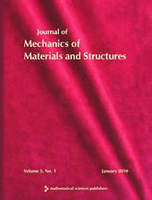
Journal of Mechanics of Materials and Structures
Fostering Academic Excellence in Material Behavior Research.Journal of Mechanics of Materials and Structures, published by Mathematical Science Publishers, is a distinguished periodical in the field of Applied Mathematics and Mechanics of Materials. With the ISSN 1559-3959, this journal has been a pivotal platform since its inception in 2006, providing insights and advancements in the mechanics of materials and their structural applications. Operating out of the University of California, Berkeley, this journal not only boasts a respectable standing within its categories, ranking Q4 in Applied Mathematics and Q3 in Mechanics of Materials as of 2023, but it also serves a crucial role in fostering academic discourse among researchers, practitioners, and students alike. Although it does not currently offer open access, its contributions to the respective fields are invaluable, underscoring the relevance and importance of continued research in understanding material behavior and structural integrity. Whether investigating theoretical frameworks or engineering applications, the Journal of Mechanics of Materials and Structures remains an essential resource for anyone dedicated to the advancement of the science of materials and structures.

ACTA MECHANICA
Catalyzing Research for Tomorrow's TechnologiesACTA MECHANICA, published by Springer Wien, is a reputable journal that has been an integral part of the fields of Computational Mechanics and Mechanical Engineering since its inception in 1965. With a strong emphasis on innovative research and advanced methodologies, the journal has established itself in the academic community, currently holding a distinguished Q2 ranking in both categories for 2023. The journal’s ISSN is 0001-5970, with an E-ISSN of 1619-6937. Furthermore, it proudly ranks #26 out of 89 in Computational Mechanics and #217 out of 672 in Mechanical Engineering in the Scopus database, placing it in the top percentiles of its respective fields. Researchers, professionals, and students can access cutting-edge articles that cover a wide range of topics, contributing significantly to ongoing dialogues and discoveries within mechanical disciplines. Though not an open-access journal, ACTA MECHANICA offers a platform for highly qualified researchers to disseminate their work, ensuring that significant findings advance the field's boundaries. For more information, visit the journal’s address at Prinz-Eugen-Strasse 8-10, A-1040 Vienna, AUSTRIA.
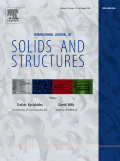
INTERNATIONAL JOURNAL OF SOLIDS AND STRUCTURES
Shaping the Landscape of Mechanical EngineeringINTERNATIONAL JOURNAL OF SOLIDS AND STRUCTURES, published by PERGAMON-ELSEVIER SCIENCE LTD, is a leading academic journal with a strong reputation in the fields of engineering and applied mathematics. Established in 1965 and converging its impact on research through 2024, this journal is highly regarded within Q1 quartile rankings across multiple disciplines, including Applied Mathematics, Condensed Matter Physics, and Mechanical Engineering. With its ISSN 0020-7683 and E-ISSN 1879-2146, the journal is systematically indexed and accessible to a global audience, although it does not currently offer open access options. Researchers, professionals, and students alike benefit from its high-impact research articles, as evidenced by its impressive Scopus rankings in various categories, including a 91st percentile in Applied Mathematics and 81st in Mechanical Engineering. The journal serves as a critical platform for the dissemination of groundbreaking findings in solid and structural mechanics, promoting innovation and collaboration within the scientific community.

STRENGTH OF MATERIALS
Exploring the mechanics that shape our world.STRENGTH OF MATERIALS is a prestigious journal published by SPRINGER that focuses on the critical field of mechanics of materials, providing an authoritative platform for the dissemination of research and developments in material strength analysis since 1969. With an ISSN of 0039-2316 and an E-ISSN of 1573-9325, this journal serves a global audience of researchers, professionals, and students, contributing essential insights into the physical properties and performance characteristics of various materials under stress and strain. As part of the United States' academic literature, it showcases work that not only advances theoretical knowledge but also applies to practical engineering scenarios. Although ranked in the Q4 tier with respect to its category in Mechanics of Materials, with a Scopus rank of #319 out of 398 (19th percentile), it remains an important resource for those looking to expand their understanding in this specialized area. Researchers can access a wealth of information through this journal, fostering continued innovation and interdisciplinary collaboration.
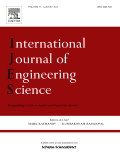
INTERNATIONAL JOURNAL OF ENGINEERING SCIENCE
Advancing the Frontiers of Engineering KnowledgeInternational Journal of Engineering Science, published by Pergamon-Elsevier Science Ltd in the United Kingdom, stands as a premier platform for pioneering research in the diverse fields of engineering and materials science. Since its inception in 1963, this journal has consistently demonstrated its commitment to advancing academic discourse, maintaining an impressive trajectory that positions it in the Q1 category across multiple engineering disciplines including Mechanical Engineering and Mechanics of Materials as of 2023. With notable Scopus rankings—placing it in the top 5% percentile for Mechanical Engineering and related fields—this journal attracts high-quality, impactful research designed for both industry practitioners and academic scholars. Although it does not currently offer Open Access options, its readership is enriched by comprehensive peer-reviewed articles, fostering a deeper understanding of complex engineering problems and innovative solutions. The International Journal of Engineering Science continues to be an invaluable resource for researchers, professionals, and students committed to pushing the boundaries of knowledge in engineering and materials science.
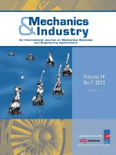
Mechanics & Industry
Advancing Engineering Excellence for AllMechanics & Industry, published by EDP SCIENCES S A, is a prominent open access journal dedicated to the fields of Industrial and Manufacturing Engineering, Materials Science, and Mechanical Engineering. Since its establishment in 2004, the journal has served as a crucial platform for disseminating innovative research and developments in mechanics, catering to a diverse audience of researchers, professionals, and students worldwide. With an ISSN of 2257-7777 and an E-ISSN of 2257-7750, the journal is indexed in Scopus and has achieved a respectable Q3 quartile ranking across its categories for 2023. Mechanics & Industry emphasizes the importance of collaborative research and the sharing of knowledge, underpinning advancements in technology and industry practices. The journal's commitment to open access ensures that research findings are available to all, promoting sustainability and innovation within the global engineering community. Located in Les Ulis, France, this journal continues to uphold high standards of scholarly excellence and relevance in an ever-evolving industrial landscape.
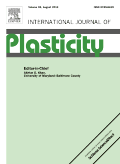
INTERNATIONAL JOURNAL OF PLASTICITY
Elevating Knowledge in the Mechanics of MaterialsINTERNATIONAL JOURNAL OF PLASTICITY, published by Pergamon-Elsevier Science Ltd, stands as a pivotal forum in the field of materials science and engineering, exploring the nuances of plastic behavior in materials. With its ISSN 0749-6419 and E-ISSN 1879-2154, this esteemed journal has been a cornerstone of academic research since its inception in 1985, continuing to hold significant relevance as it converges towards 2024. Ranking in the Q1 quartile across multiple categories, including Materials Science (Miscellaneous), Mechanical Engineering, and Mechanics of Materials, it is recognized for its high impact, evidenced by its competitive Scopus rankings that place it in the 97th percentile among mechanical engineering journals. Although it does not offer open access, the journal remains committed to disseminating cutting-edge research findings that advance understanding in plasticity, providing researchers, professionals, and students with vital insights into contemporary issues and innovations in the field.

Materials Physics and Mechanics
Innovating Insights in Physics and EngineeringMaterials Physics and Mechanics is a pivotal journal dedicated to advancing the fields of condensed matter physics, materials science, mechanical engineering, and the mechanics of materials. Published by the Institute of Problems in Mechanical Engineering, Russian Academy of Sciences, this journal has established itself as a valuable resource since its inception, particularly from 2003 to 2004 and now continuously from 2009 to 2024. Although it currently holds a Q4 categorization in various disciplines, its contributions are critical to understanding and developing new materials and their applications in engineering. The journal provides insightful articles that explore the nuances of material properties, their behaviors under different conditions, and the physical principles governing these phenomena. Though it operates under a traditional publication model, the insights provided within its pages are invaluable to researchers, professionals, and students striving to push the boundaries of knowledge in the materials domain. Its ISSN numbers (1605-2730, E-ISSN 1605-8119) serve as a gateway to a wealth of scientific knowledge emanating from the Russian Federation, contributing to the global discourse in materials physics and mechanics.
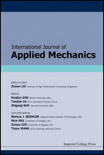
International Journal of Applied Mechanics
Shaping the Future of Applied Mechanics ScholarshipThe International Journal of Applied Mechanics, published by World Scientific Publishing Co Pte Ltd, is a premier platform that serves the fields of materials science, mechanical engineering, and mechanics of materials. Located in Singapore, this journal has established itself as a crucial resource for researchers, professionals, and students, with its convergence of scholarly work from 2009 to 2024. Ranked in the Q2 category across notable disciplines, including Materials Science, Mechanical Engineering, and Mechanics of Materials, it reflects a strong commitment to publishing high-quality research that pushes the boundaries of knowledge in applied mechanics. Despite being a non-open access journal, its successful Scopus rankings, including an impressive rank of #151 in Mechanical Engineering, signify its substantial impact and recognition within the academic community. This journal not only aims to disseminate pioneering research but also to foster collaboration and innovation in the rapidly evolving landscape of applied mechanics.